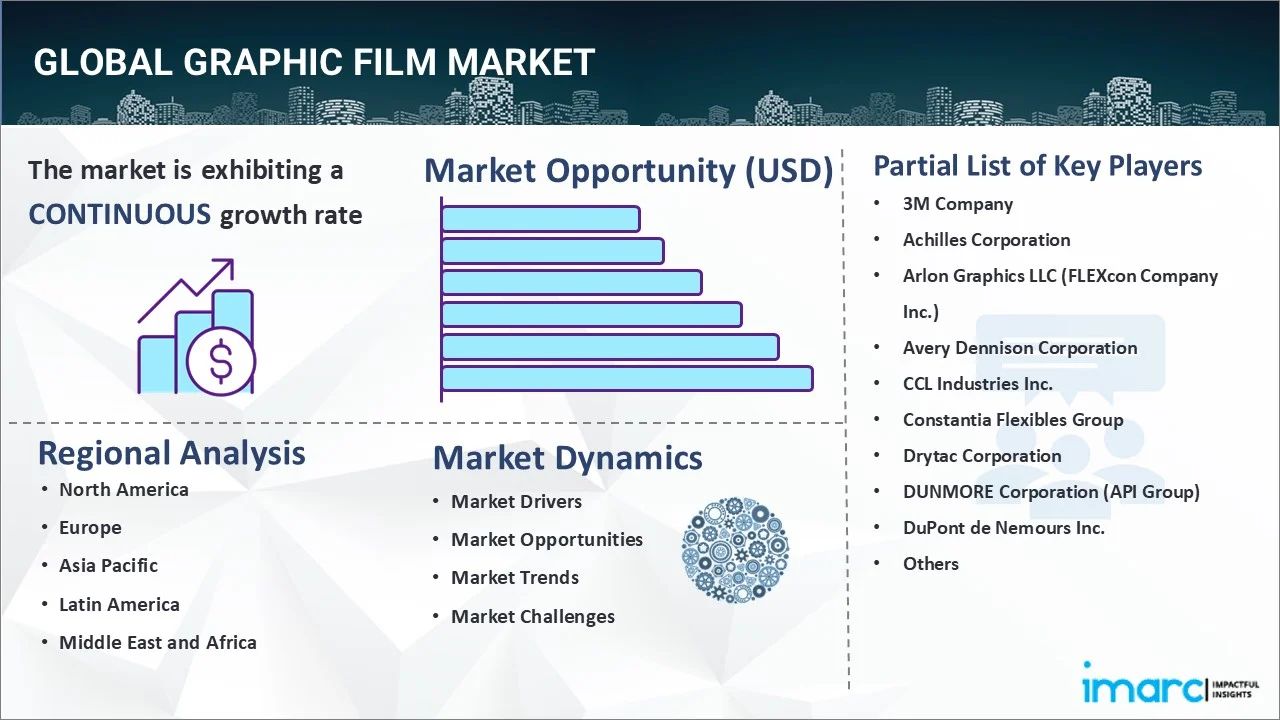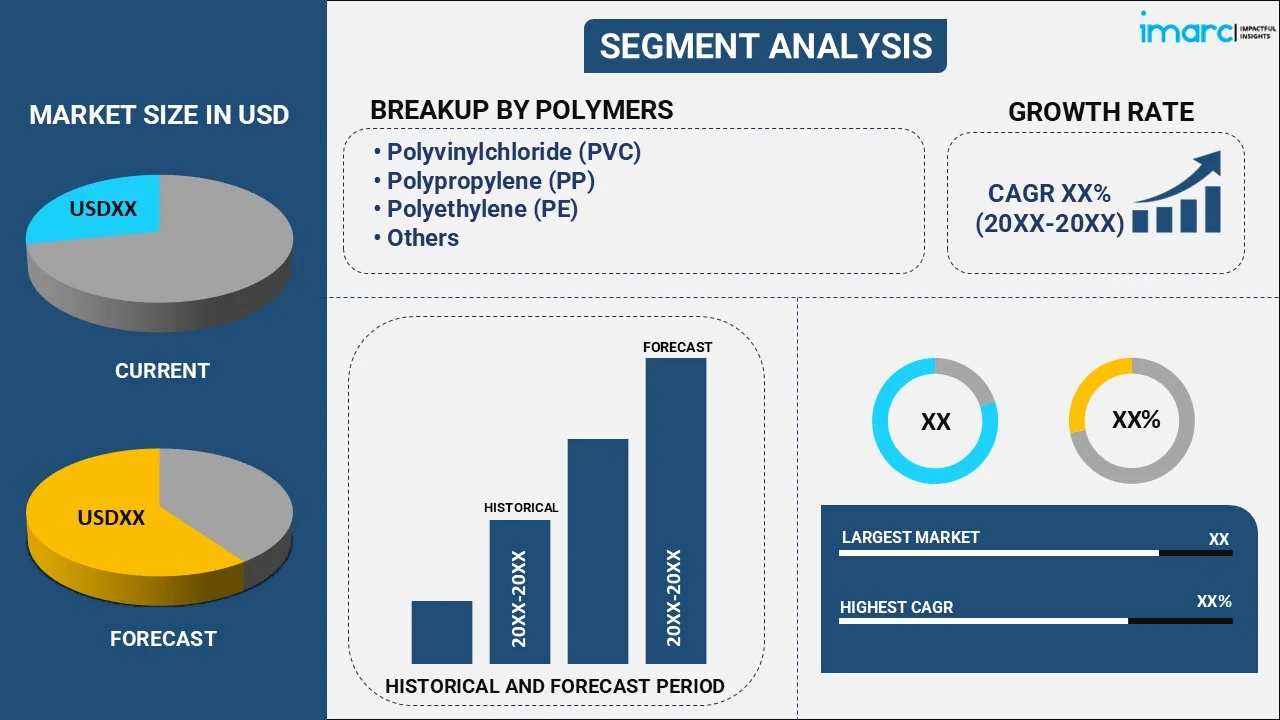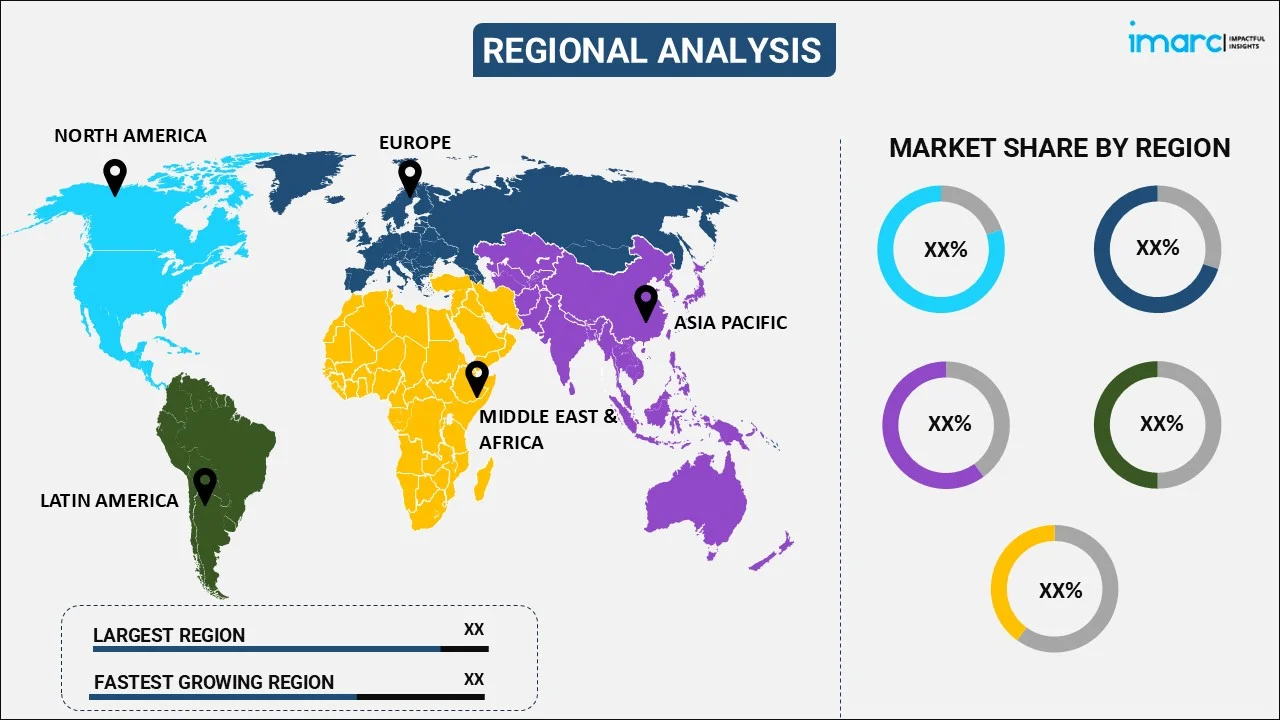
Graphic Film Market Report by Polymer (Polyvinylchloride (PVC), Polypropylene (PP), Polyethylene (PE), and Others), Film Type (Reflective, Opaque, Transparent, Translucent), Printing Technology (Rotogravure, Flexography, Offset, Digital), End Use (Promotional and Advertisement, Automotive, and Others), and Region 2025-2033
Graphic Film Market Overview:
The global graphic film market size reached USD 30.1 Billion in 2024. Looking forward, IMARC Group expects the market to reach USD 42.8 Billion by 2033, exhibiting a growth rate (CAGR) of 3.57% during 2025-2033. The increasing demand for branding and marketing, the widespread adoption of graphic film in the automotive industry, and the growing popularity of graphic films in both commercial and residential settings are some of the key factors driving the market.
|
Report Attribute
|
Key Statistics
|
|---|---|
|
Base Year
|
2024
|
|
Forecast Years
|
2025-2033
|
|
Historical Years
|
2019-2024
|
|
Market Size in 2024
|
USD 30.1 Billion |
|
Market Forecast in 2033
|
USD 42.8 Billion |
| Market Growth Rate 2025-2033 | 3.57% |
Graphic film, also known as visual communication or motion graphics, is a type of creative expression that combines design, animation, and cinematography to tell a story or convey a message. It is produced utilizing various methods, such as traditional animation, computer-generated imagery (CGI), stop-motion animation, and live-action video. It may communicate complicated ideas and emotions in a way that audiences can easily understand by using visuals, text, and animation. Additionally, it is frequently used in marketing and advertising to advertise goods or services. Advertisers can produce visually arresting advertising that captures viewers' attention and effectively explain the characteristics and benefits of a product or service by utilizing animation and motion graphics. As a result, it is gaining widespread prominence across the globe since graphic film is a potent form of visual expression that combines design, animation, and cinematography to produce visually attractive and emotionally compelling films.

Graphic Film Market Trends:
The escalating demand for branding and marketing majorly drives the global market. This can be supported by the rising popularity of social media and digital marketing that leads to a significant increase in demand for branding and marketing materials. In order to produce eye-catching and compelling graphics for use in advertising and promotional materials, many businesses are preferring graphic films over other materials. The market is further driven by the extensive utilization of graphic films in the manufacturing of custom graphics widely used for storefronts, vehicle wraps, and other kinds of signs. Along with this, the widespread adoption of graphic film in the automotive industry for producing decals as it is highly durable and can be printed with custom designs. In addition, the growing popularity of graphic films in both commercial and residential settings to enhance the energy efficiency of buildings by reducing solar heat gain and glare, while still allowing natural light to enter is significantly supporting the market. Apart from this, numerous leading manufacturers are focusing on creating sustainable and environmentally friendly products by developing eco-friendly films from renewable materials, such as biodegradable plastics and recyclable materials are driving the demand on the global level. Furthermore, continual advancements in printing technology to produce high-resolution graphics on a variety of materials, including vinyl, polyester, and other plastic films are creating a positive market outlook.
Key Market Segmentation:
IMARC Group provides an analysis of the key trends in each sub-segment of the global graphic film market report, along with forecasts at the global, regional and country level from 2025-2033. Our report has categorized the market based on polymer, film type, printing technology and end use.
Polymer Insights:

- Polyvinylchloride (PVC)
- Polypropylene (PP)
- Polyethylene (PE)
- Others
The report has provided a detailed breakup and analysis of the graphic film market based on the polymer. This includes polyvinylchloride (PVC), polypropylene (PP), polyethylene (PE), and others. According to the report, polyvinylchloride (PVC) represented the largest segment.
Film Type Insights:
- Reflective
- Opaque
- Transparent
- Translucent
A detailed breakup and analysis of the graphic film market based on the film type have also been provided in the report. This includes reflective, opaque, transparent, and translucent. Amongst these, opaque represents the largest segment.
Printing Technology Insights:
- Rotogravure
- Flexography
- Offset
- Digital
The report has provided a detailed breakup and analysis of the graphic film market based on the printing technology. This includes rotogravure, flexography, offset, and digital. According to the report, flexography represented the largest segment.
End Use Insights:
- Promotional and Advertisement
- Automotive
- Others
A detailed breakup and analysis of the graphic film market based on the end use have also been provided in the report. This includes promotional and advertisement, automotive, and others. Amongst these, promotional and advertisement represent the largest segment.
Regional Insights:

- North America
- United States
- Canada
- Asia-Pacific
- China
- Japan
- India
- South Korea
- Australia
- Indonesia
- Others
- Europe
- Germany
- France
- United Kingdom
- Italy
- Spain
- Russia
- Others
- Latin America
- Brazil
- Mexico
- Others
- Middle East and Africa
The report has also provided a comprehensive analysis of all the major regional markets, which include North America (United States, Canada); Asia-Pacific (China, Japan, India, South Korea, Australia, Indonesia, others); Europe (Germany, France, United Kingdom, Italy, Spain, Russia, others); Latin America (Brazil, Mexico, others); and the Middle East and Africa. According to the report, Asia-Pacific was the largest market for the graphic film. Some of the factors driving Asia-Pacific graphic film market included rapid industrialization, significant growth in the automotive industry, continual technological advancements, etc.
Competitive Landscape:
The report has also provided a comprehensive analysis of the competitive landscape in the global graphic film market. Competitive analysis such as market structure, market share by key players, player positioning, top winning strategies, competitive dashboard, and company evaluation quadrant has been covered in the report. Also, detailed profiles of all major companies have been provided. Some of the companies covered are 3M Company, Achilles Corporation, Arlon Graphics LLC (FLEXcon Company Inc.), Avery Dennison Corporation, CCL Industries Inc., Constantia Flexibles Group, Drytac Corporation, DUNMORE Corporation (API Group), DuPont de Nemours Inc., FDC Graphic Films Inc., Hexis S.A. and Kay Premium Marking Films Ltd. (ORAFOL Europe GmbH). Kindly note that this only represents a partial list of companies, and the complete list has been provided in the report.
Report Coverage:
| Report Features | Details |
|---|---|
| Base Year of the Analysis | 2024 |
| Historical Period | 2019-2024 |
| Forecast Period | 2025-2033 |
| Units | Billion USD |
| Segment Coverage | Polymer, Film Type, Printing Technology, End Use, Region |
| Region Covered | Asia Pacific, Europe, North America, Latin America, Middle East and Africa |
| Countries Covered | United States, Canada, Germany, France, United Kingdom, Italy, Spain, Russia, China, Japan, India, South Korea, Australia, Indonesia, Brazil, Mexico |
| Companies Covered | 3M Company, Achilles Corporation, Arlon Graphics LLC (FLEXcon Company Inc.), Avery Dennison Corporation, CCL Industries Inc., Constantia Flexibles Group, Drytac Corporation, DUNMORE Corporation (API Group), DuPont de Nemours Inc., FDC Graphic Films Inc., Hexis S.A., Kay Premium Marking Films Ltd. (ORAFOL Europe GmbH) |
| Customization Scope | 10% Free Customization |
| Post-Sale Analyst Support | 10-12 Weeks |
| Delivery Format | PDF and Excel through Email (We can also provide the editable version of the report in PPT/Word format on special request) |
Key Benefits for Stakeholders:
- IMARC’s report offers a comprehensive quantitative analysis of various market segments, historical and current market trends, market forecasts, and dynamics of the graphic film market from 2019-2033.
- The research study provides the latest information on the market drivers, challenges, and opportunities in the global graphic film market.
- The study maps the leading, as well as the fastest-growing, regional markets. It further enables stakeholders to identify the key country-level markets within each region.
- Porter's five forces analysis assist stakeholders in assessing the impact of new entrants, competitive rivalry, supplier power, buyer power, and the threat of substitution. It helps stakeholders to analyze the level of competition within the graphic film industry and its attractiveness.
- Competitive landscape allows stakeholders to understand their competitive environment and provides an insight into the current positions of key players in the market.
Key Questions Answered in This Report
The global graphic film market was valued at USD 30.1 Billion in 2024.
We expect the global graphic film market to exhibit a CAGR of 3.57% during 2025-2033.
The rising demand for graphic films in vehicles, floors and sidewalks, windows and glasses, road signs, overlaminates, etc., as they are water-resistant, recyclable, durable, and has low installation and maintenance costs, is primarily driving the global graphic film market.
The sudden outbreak of the COVID-19 pandemic had led to the implementation of stringent lockdown regulations across several nations, resulting in the temporary halt in numerous production activities for graphic films.
Based on the polymer, the global graphic film market has been segmented into Polyvinylchloride (PVC), Polypropylene (PP), Polyethylene (PE), and others, where Polyvinylchloride (PVC) currently holds the majority of the total market share.
Based on the film type, the global graphic film market can be divided into reflective, opaque, transparent, and translucent. Currently, opaque exhibits a clear dominance in the market.
Based on the printing technology, the global graphic film market has been categorized into rotogravure, flexography, offset, and digital. Among these, flexography currently accounts for the largest market share.
Based on the end use, the global graphic film market can be bifurcated into promotional and advertisement, automotive, and others. Currently, promotional and advertisement exhibits a clear dominance in the market.
On a regional level, the market has been classified into North America, Asia-Pacific, Europe, Latin America, and Middle East and Africa, where Asia-Pacific currently dominates the global market.
Some of the major players in the global graphic film market include 3M Company, Achilles Corporation, Arlon Graphics LLC (FLEXcon Company Inc.), Avery Dennison Corporation, CCL Industries Inc., Constantia Flexibles Group, Drytac Corporation, DUNMORE Corporation (API Group), DuPont de Nemours Inc., FDC Graphic Films Inc., Hexis S.A., and Kay Premium Marking Films Ltd. (ORAFOL Europe GmbH)
Need more help?
- Speak to our experienced analysts for insights on the current market scenarios.
- Include additional segments and countries to customize the report as per your requirement.
- Gain an unparalleled competitive advantage in your domain by understanding how to utilize the report and positively impacting your operations and revenue.
- For further assistance, please connect with our analysts.
 Inquire Before Buying
Inquire Before Buying
 Speak to an Analyst
Speak to an Analyst
 Request Brochure
Request Brochure
 Request Customization
Request Customization




.webp)




.webp)












